| |
| |

The many comebacks from the brink of extinction, and extinctions of Chatham Islands birds
2 July 2008
In a country renowned for a number of the world's rarest animals, the Chatham Islands is the home of more endangered birds than any other region of New Zealand.
Four of the five New Zealand critically endangered seabirds on the IUCN Red List only breed in the Chatham Islands.
A quarter of the New Zealand "nationally critical" listed birds were found only in the Chatham Islands, before conservation actions translocated them to alternative predator-free island locations.
A fifth of the "nationally endangered" birds are endemic to the Chatham Islands.
Five bird species with populations reduced to less than 150, well on their way to extinction, have made remarkable recoveries with human intervention.
Separate species of robin, pigeon, warbler, parakeet, snipe, shag and oystercatcher that have speciated from mainland birds, and subspecies of tui, tit, kakariki, blue penguin and fulmar prion, are endemic to the Chatham Islands. |
| |
 |
| |
Four of the five New Zealand critically endangered seabirds on the IUCN Red List only breed in the Chatham Islands. |
| |
 |
| |
| The rare fauna is the result of the long isolation and the 800 km separation east from the mainland. The archipelago consists of 10 small islands covering a total area of 966 sq.km, mainly with Chatham and Pitt Islands which are the only inhabited islands.
|
| |
No other rare bird populations have been so damaged by the removal of their native habitat, devastating intrusion of introduced predators, human hunting for food, and commercial fishing in the adjoining ocean.
Two nationally critical terrestrial birds .....
One of the world's most spectacular comebacks from the brink of extinction occurred in the Chatham Islands. The heavy burden for the survival of the Black robin Petroica traversi which was only found on Mangere Island, fell on the shoulders of the only remaining female named Old Blue. She chose one of four remaining males, Old Yellow, as her breeding partner, and all black robins living today are descendents of this pair. |
| |
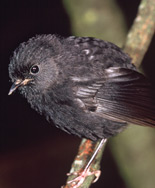 |
The black robin's status on the 2007 IUCN Red List of Threatened Species has improved from "critically endangered" to "endangered", but it is still "nationally critical" on the 2005 New Zealand Threat Classification System.
 View larger black robin images View larger black robin images
The Chatham Island pigeon (Parea) Hemiphaga chathamensis (left middle) is found in the Tuku Nature Reserve and in Chatham Island forest remnants. The number of birds got as low as 40 in 1986. Parea made a remarkable recovery, because of predator and hunting control, and by 1996 there were about 200 birds.
The parea has evolved into a separate species from the mainland pigeon, kereru Hemiphaga novaeseelandiae. The parea looks a lot like a keruru on steroids.
H. chathamensis is distinguished by its larger body size, shorter wings and tail, and other appearance and structural differences from H. novaeseelandiae which is more prevalent throughout New Zealand and is listed as 'gradual decline'.
 View larger pigeon images View larger pigeon images
The Chatham Island snipe Coenocorypha pusilla is listed as "vulnerable" on the IUCN Red List and "range restricted" on the NZ Threat Classification. The juvenile Snares Island snipe (left lower) closely resembles its Chatham Island relative.
|
| |
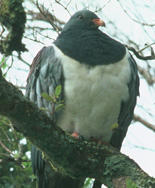 |
| |
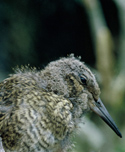 |
| |
Other endemic forest birds include the Chatham Island warbler Gerygone albofrontata, "nationally endangered" Chatham Island tui Prosthemadera novaeseelandiae chathamensis, "nationally endangered" Chatham Island tomtit Petroica macrocephala chathamensis, and Chatham Island fantail Rhipidura fuliginosa penitus. |
| |
An endangered and a vulnerable parakeet co-inhabiting and crossbreeding ..... |
| |
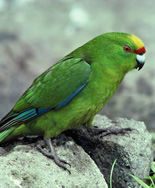 |
Forbes' parakeet Cyanoramphus forbesi is endemic to Mangere Island. It was first described as a distinct species in 1893, then demoted to a subspecies of yellow-crowned parakeet in 1930. Genetic research in 2001 redeems C. forbesi as a separate species.
Forbes' parakeet lineage connects to the Chatham Island red-crowned parakeet Cyanoramphus novaezelandiae chathamensis which coexists in the same habitat. This endangers the smaller C. forbesi population by hybridisation with the stronger C. n. chathamensis.
The Chatham Island red-crowned parakeet is one two remaining subspecies each found only on the Chatham Islands, and Kermadec Islands. The New Zealand red-crowned parakeet Cyanoramphus novaezelandiae was once abundant throughout New Zealand, but is rarely seen now on the mainland.
|
| |
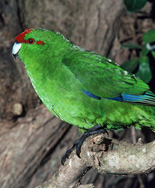 |
| |
Its stronghold is Ewing Island in the subantarctic Auckland Islands, which is the world's most southern parrot location. It is also the only parakeet on Stewart Island, and translocated birds are doing well on predator-free Kapiti Island, and 3 Hauraki Gulf islands. Forbes' parakeet is in desperate need of its own island. |
| |
Two nationally critical shorebirds .....
The endemic New Zealand shore plover (Tuturuata) Thinornis novaeseelandiae (below top) which is "nationally critical" on the NZ Threat list, and "threatened" on the Red List, was once found around the New Zealand coastline, but became extinct on the mainland by the 1870s. It is one of the world's rarest shore birds.
By 1937, predator-free Rangitira Island and the Western Reef in the Chatham Islands provided the only safe habitat, with the entire population reduced to only 72 pairs. Reversion to forest of pasture used for nesting caused further loss, but the population stablized with 45 to 50 pairs.
Decline of a population of 21 on Western Reef declined after they were discovered, and the last bird was removed for breeding in 2003. Half a dozen pairs are now breeding on nearby Mangere Island after transfer from Rangitira but the tiny island is at full capacity. |
| |
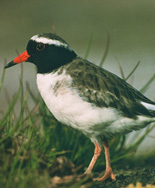 |
Releases of 71 captive-bred birds to Motuora Island in the Hauraki Gulf from 1994 to 1998 was unsuccessful because of dispersion and morepork predation and was abandoned in 2005.
In 2006, 15 captive-bred juveniles released on Raratoka Island in Foveaux Strait south of the South Island all dispersed. DoC plans to try more releases there with wild-reared birds.
About 100 captive-bred birds were established on an undisclosed island off the east coast of the North Island from 1998 to 2005. Forty captive juveniles were released on Mana Island in 2007, and one pair laid their first eggs later the same year.
 View larger shore plover images View larger shore plover images
The Chatham Island oystercatcher Haematopus chathamensis (left) which is "nationally critical" on the NZ Threat list, and "threatened" on the Red List, is endemic to Rangitira, Pitt, Mangere and Chatham Islands. |
| |
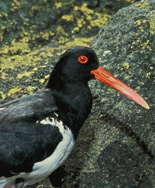 |
| |
In 2004 there were 88 breeding pairs and 311 birds, which is more than twice the population since DoC's intensive management plan started in 1998. The recovery plan focusses on restoration of the natural ecology of the coastline, the oystercatcher's sand dune breeding habitat, aimed at bringing the population back up tp 250 birds.
 View larger oystercatcher images View larger oystercatcher images
|
| |
Four critically endangered seabirds .....
Four of the five New Zealand seabirds listed as "critically endangered" on the 2007 IUCN Red List only breed in the Chatham Islands. There are a total of 10 New Zealand birds listed as "critically endangered".
The Chatham Island taiko, Chatham petrel, Gallapagos petrel and Jamaica petrel share the "critically endangered" distinction, and are the rarest and most threatened of the 32Pterodroma species listed on the IUCN Red List. |
| |
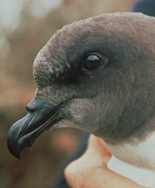 |
The Chatham Island taiko Pterodroma magentae, also known as the magenta petrel, is one of six New Zealand birds that were thought to be extinct, but were rediscovered since the mid-20th century.
 View larger taiko image View larger taiko image
The cause of decline of the Chatham Island shag Leucocarbo onslow is not known. It is endemic to the Chatham Islands group, and only breeds in a total area of one hectare on three islands.
There are small colonies at Manakau Point on Chatham Island, and on Star Keys Island and Rabbit Island. Because of the small population, the status of the Chatham Island shag on the IUCN Red List was upgraded to 'critically endangered' in 2005.
 View larger shag images View larger shag images
The Chatham Island mollymawk Thalassarche eremita which is also known as the Chatham albatross, is one of two albatrosses in the world that is 'critically endangered' on the IUCN Red List. It only breeds on Pyramid Island, a small rock outcrop in the Chatham Islands.
During the breeding season it is mainly found within 300km of the colony along the continental shelf, while at other times it disperses west to Tasmania, and east to Chile and Peru. The 11,000 bird population shows little sign of decline, however, the island habitat has been damaged by storms, and the mollymawk is vulnerable to longline fishing.
 View larger mollymawk images View larger mollymawk images |
| |
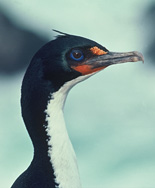 |
| |
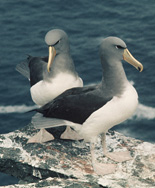 |
| |
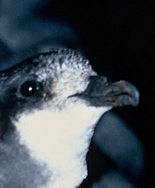 |
| |
The remaining 1000 Chatham petrel Pterodroma axillaris were confined for many years to Rangatira Island. The Department of Conservation is establishing a second population on adjoining Pitt Island where it has been absent for more than 100 years.
After translocating 200 chicks to a 40ha predator-free enclosure in an attempt to establish their new breeding location, four petrels have returned to Pitt Island, with one pair producing the first fledgling in 2006. The success of this new conservation technique for a migratory seabird will be invaluable for many species.
 View larger Chatham petrel image View larger Chatham petrel image
Other seabirds that breed in the Chatham group include the "endangered" Northern Royal Albatross (Toroa) Diomedea sanfordi which also breeds at Taiaroa Head on the Otago coast, and the "endangered" Pitt Island shag Strictocarbo featherstoni |
| |
Nine Chatham Islands bird extinctions .....
More extinctions have occurred in the Chatham Islands than any other region of New Zealand. |
| |
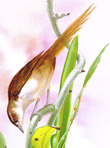 |
Very little was learned about the Chatham Island fernbird Bowdleria rufescens which was the size of a house sparrow. The first bird discovered in 1868 was killed by a stone thrower. It was only found on Pitt and Mangere Islands.
The last specimen was shot for Lord Walter Rothchild's collection in about 1900. B. rufescens was related to the five weak flying B. punctata subspecies on both mainland islands, Stewart and Codfish Islands, and subantarctic Snares Island.
 View larger fernbird image View larger fernbird image
The total number of endemic rail species in New Zealand was 17, of which 11 are extinct. All of the four Chatham Islands rail species are extinct.
About 26 specimens of Chatham rail Gallirallus modestus, sometimes called the "modest rail" because of its small size, remain in museums, collected from its discovery in 1871 until extinction in 1900. |
| |
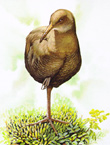 |
| |
G. modestus and Dieffenbach's rail Gallirallus dieffenbachii, co-existed on at least three islands in the Chatham group, descending from G. philippensis which had dispersed throughout the Pacific. The two diverged from their volant ancestor, becoming flightless but with G. dieffenbachii growing larger, and G. modestus smaller to the size of a blackbird, with a long specialised feeding bill. Images Copyright © Peter Schouton
 View larger Chatham rail image View larger Chatham rail image
The flightless Giant Chatham Island rail, also known as Hawkin's rail Diaphorapteryx hawkinsi was endemic to the main Chatham and Pitt Islands. It is known that the 16 inch tall, 4.5 pound bird was eaten by Moriori from the skeletal remains found in middens. There is no record of whenD. hawkinsi was last seen, but it may have existed until the end of the 19th century.
and the Chatham Island coot Fulica chathamensis |
|
Extinctions since mid-19th century European settlement include the Chatham Island bellbird Anthornis melanocephala. endemic to Chatham, Mangere and Litle Mangere Islands. It was last seen on Little Mangere Island in 1906. The bellbird's decline remains a mystery because Little Mangere had no forest or predators, so the usual reasons of deforrestation and introduced mammal predation were not the cause.
Of the 20 extinctions throughout New Zealand since 14th century Maori settlement, the Chatham Islands lost four species endemic to the island group.
Chatham Island raven Corvus moriorum world's fifth largest passerine
Chatham Island sea-eagle Haliaeetus australis
Giant Chatham Island snipe Coenocorypha chathamica also known as Forbe's snipe is only known from fossil records may have survived unnoticed until the 19th century
Chatham Island duck Pachyanas chathamica
New Zealand swan Cygnus sumnerensis
|
| |
 |
| |
|
| |
Above top L to R: Black robin Petroica traversi, Chatham Island pigeon Hemiphaga chathamensis, Snares Island snipe juvenile Coenocorypha aucklandica huegeli, Forbes' parakeet Cyanoramphus forbesi, and New Zealand shore plover Thinornis novaeseelandiae.
Above lower L to R: Chatham Island oystercatcher Haematopus chathamensis, Taiko (Magenta petrel) Pterodroma magentae, Chatham Island shag Leucocarbo onslowi, Chatham albatross Thalassarche eremita, Chatham petrel Pterodroma axillaris. Photos: Crown Copyright © Department of Conservation
 Click on each image to see more Click on each image to see more
|
| |
Five species nearly lost with populations reduced to less than 150 .....
Five Chatham Island birds came perilously close to extinction with populations reduced to less than 150, and even down to 5. All of their breeding habitats were severely restricted, from one to three locations.
The Black robin came as close as it gets to extinction with one female and four males. It was only found on three small islands.
The Chatham Island pigeon population got down to 40 birds in 1986.
The last surviving 120 New Zealand shore plover were all that remained on Rangitira Island and Western Reef, after being widespread on the mainland.
The Chatham Island oystercatcher population was down to 150 birds in 1998.
The Chatham Island taiko was thought to be extinct for 111 years before 2 birds were found in 1973, although other birds may have been living. |
| |
2007 IUCN Red List of Threatened Species
Chatham Island taiko (Magenta petrel)
Pterodroma magentae
Critically endangered
Chatham petrel
Pterodroma axillaris
Critically endangered
Chatham Island shag
Leucocarbo onslowi
Critically endangered
Chatham albatross
Thalassarche eremita
Critically endangered
Pitt Island shag
Phalacrocorax featherstoni
Endangered
Black robin
Petroica traversi
Endangered
New Zealand shore plover
Thinornis novaeseelandiae
Endangered
Chatham Island oystercatcher
Haematopus chathamensis
Endangered
Forbe's parakeet
Cyanoramphus forbesi
Endangered
Red-fronted parakeet
Cyanoramphus novaezelandiae
Vulnerable
Chatham Island snipe
Coenocorypha pusilla
Vulnerable
Chatham Island warbler
Gerygone albofrontata
Least concern |
|
| |
2005 New Zealand Threat Classification System
Chatham Island taiko (Magenta petrel)
Pterodroma magentae
[1] Nationally critical
Black robin (Chatham Island robin) Petroica traversi
[1] Nationally critical
Chatham Island oystercatcher
Haematopus chathamensis
[1] Nationally critical
Chatham Island pigeon (Parea)
Hemiphaga chathamensis
[1] Nationally critical
New Zealand shore plover
Thinornis novaeseelandiae
[1] Nationally critical
Chatham petrel
Pterodroma axillaris
[2] Nationally endangered
Chatham Island shag
Leucocarbo onslowi
[2] Nationally endangered
Chatham Island tui
Prosthemadera novaeseelandiae chathamensis
[2] Nationally endangered
Chatham Island tit
Petroica macrocephala chathanensis
[2] Nationally endangered
Forbe's parakeet
Cyanoramphus forbesi
[2] Nationally endangered
Pitt Island shag
Stictocarbo featherstoni
[3] Nationally vulnerable
Chatham Island mollymawk
Thalassarche eremita
[4] Serious decline
Chatham Island snipe
Coenocorypha pusilla
[7] Range restricted
Chatham Island red-crowned kakariki
Cyanoramphus novaezelandiae chathamensis
[7] Range restricted
Chathams little blue penguin
Eudyptula minor chathamensis
[7] Range restricted
Chatham Island warbler
Gerygone albofrontata
[7] Range restricted
Chatham Island fulmar prion
Pachyptila crassirostris pyramidalis
[7] Range restricted |
|
| |
Chatham Island extinctions
Chatham Island bellbird
Anthornis melanocephala
Chatham rail
Cabalus modestus
Dieffenbach's rail
Gallirallus dieffenbachii
Giant Chatham Island rail
Diaphorapteryx hawkinsi
Forbe's snipe
Coenocorypha chathamica
Chatham Islands raven
Corvus moriorum
Chatham Islands fernbird
Bowdleria rufescens
Chatham Island sea-eagle
Haliaeetus australis
Giant Chatham Island rail
Diaphorapteryx hawkinsi
New Zealand coot
Fulica chathamensis
Giant Chatham Island snipe
Coenocorypha chathamica
Chatham Island duck
Pachyanas chathamica
Chatham Islands penguin
Eudyptes sp. |
| |
 |
| |
 |
|


